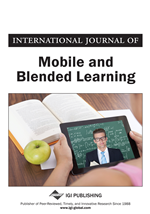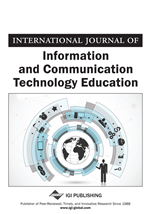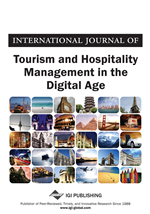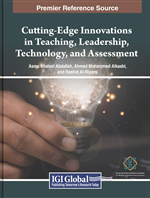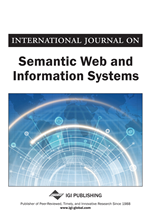Search
Results: 26
Online Collaborative Learning Using Microsoft Teams in Higher Education Amid COVID-19
Due to the COVID-19 pandemic, most universities needed to move to online teaching and learning, in some cases with very limited knowledge or experience in running online programmes. Engaging students online has become an...
Published by: IGI Global Scientific Publishing
Factors Affecting the Intention and Use of Metaverse
The metaverse is a mixed blend of digital and tangible worlds, indicating the future directions of Internet sector development. This study aimed to assess the factors affecting students' intentions to use a metaverse platform....
Published by: IGI Global Scientific Publishing
Community Empowerment and Communication Role in Creating Consensus and Acceptability for Innovative Tourism to Support Diversified Economy Oman
The present research investigates community empowerment and communication's role in promoting community support for innovative, sustainable tourism development. It also examines community support, perceived benefits, perceived...
Published by: IGI Global Scientific Publishing
The Impact of Technostress Components on the Employees Satisfaction and Perceived Performance
The present study investigates the effects of technostress creators and inhibitors on job satisfaction, organizational commitment and perceived performance. A research model derived from the Transaction-Based Model of Stress and...
Published by: IGI Global Scientific Publishing
Alternative Assessment Methods
The chapter delves into the realm of educational assessment, emphasizing the pivotal role it plays in understanding learners' skills and competencies. It scrutinizes the flaws of the standardized testing methods as primary...
Educational Technologies Education Educational Technologies Computer Science and Information Technology Library and Information Science
Published by: IGI Global Scientific Publishing
Quantifying persistence in the T-cell signaling network using an optically controllable antigen receptor.
T cells discriminate between healthy and infected cells with remarkable sensitivity when mounting an immune response, which is hypothesized to depend on T cells combining stimuli from multiple antigen-presenting cell...
Mobile Application System Efficiency and the Degree of User Satisfaction in Accessing Information
The purpose of this study was to explore the degree of user satisfaction with the use of mobile application systems to access information, specifically, the Moodle learning management system. Using quantitative methods, the...
Published by: IGI Global Scientific Publishing
Quantifying persistence in the T‐cell signaling network using an optically controllable antigen receptor
Abstract: T cells discriminate between healthy and infected cells with remarkable sensitivity when mounting an immune response, which is hypothesized to depend on T cells combining stimuli from multiple antigen‐presenting cell...
EMBO41 EMBO19 EMBO37 article ARTICLES Cell Signaling optogenetics Receptors T cells Transcription Factors
Published by: Molecular Systems Biology
Vasohibin-1 is identified as a master-regulator of endothelial cell apoptosis using gene network analysis.
Muna Affara, Debbie Sanders, Hiromitsu Araki, Yoshinori Tamada, Benjamin J Dunmore, Sally Humphreys, Seiya Imoto, Christopher Savoie, Satoru Miyano, Satoru Kuhara, David Jeffries, Cristin Print, D Stephen Charnock-Jones
Apr 06, 2020
BACKGROUND: Apoptosis is a critical process in endothelial cell (EC) biology and pathology, which has been extensively studied at protein level. Numerous gene expression studies of EC apoptosis have also been performed, however...
MMP1 bimodal expression and differential response to inflammatory mediators is linked to promoter polymorphisms.
Muna Affara, Benjamin J Dunmore, Deborah A Sanders, Nicola Johnson, Cristin G Print, D Stephen Charnock-Jones
Jun 16, 2011
Cells Cultured Chromatin Immunoprecipitation Female GATA3 Transcription Factor Humans Immunoblotting Inflammation Mediators Interleukin-1beta Interleukin-8 Matrix Metalloproteinase 1 Oligonucleotide Array Sequence Analysis Polymorphism Single Nucleotide Protein Binding Proto-Oncogene Protein c-ets-1 Proto-Oncogene Protein c-ets-2 Reverse Transcriptase Polymerase Chain Reaction Tumor Necrosis Factor-alpha
Dissecting the stability of Atezolizumab with renewable amino acid-based ionic liquids
Bayan Alkhawaja, Faisal Al-Akayleh, Zaid Al-Rubaye, Ghayda' AlDabet, Muna Bustami, Maisa’a Smairat, Ahmed S.A.A. Agha, Jehad Nasereddin, Nidal Qinna, Andreas Michael, Andrew Watts
Jun 30, 2024
Monoclonal antibodies (mAbs) have revolutionised the biopharmaceutical market. Being proteinaceous, mAbs are prone to chemical and physical instabilities. Various approaches were attempted to stabilise proteins against...
The mitochondrial oxidoreductase CHCHD4 is present in a semi-oxidized state in vivo.
Alican J Erdogan, Muna Ali, Markus Habich, Silja L Salscheider, Laura Schu, Carmelina Petrungaro, Luke W Thomas, Margaret Ashcroft, Lars I Leichert, Leticia Prates Roma, Jan Riemer
Jun 19, 2018
Disulfide formation in the mitochondrial intermembrane space is an essential process catalyzed by a disulfide relay machinery. In mammalian cells, the key enzyme in this machinery is the oxidoreductase CHCHD4/Mia40. Here, we...
The Association for Human Pharmacology in the Pharmaceutical Industry London Meeting October 2019
Shahzadgai Khan, Muna Albayaty, James Bush, Joseph Cheriyan, Anthea Cromie, Annelize Koch, Michael Hammond, Stuart Mair, Ulrike Lorch, Steffan Stringer, Jorg Taubel, Timothy C Hardman
Dec 22, 2020
The Association for Human Pharmacology in the Pharmaceutical Industry (AHPPI) annual meeting focused on impending change, innovation, and future challenges facing early phase drug development as we move into the second decade of...
The Association for Human Pharmacology in the Pharmaceutical Industry London Meeting October 2019
Shahzadgai Khan, Muna Albayaty, James Bush, Joseph Cheriyan, Anthea Cromie, Annelize Koch, Michael Hammond, Stuart Mair, Ulrike Lorch, Steffan Stringer, Jorg Taubel, Timothy C. Hardman
Dec 03, 2020
The Association for Human Pharmacology in the Pharmaceutical Industry (AHPPI) annual meeting focused on impending change, innovation, and future challenges facing early phase drug development as we move into the second decade of...
Dissecting the stability of Atezolizumab with renewable amino acid-based ionic liquids
Bayan Alkhawaja, Faisal Al-Akayleh, Zaid Al-Rubaye, Ghayda' AlDabet, Muna Bustami, Maisa’a Smairat, Ahmed S.A.A. Agha, Jehad Nasereddin, Nidal Qinna, Andreas Michael, Andrew Watts
Jun 30, 2024
Monoclonal antibodies (mAbs) have revolutionised the biopharmaceutical market. Being proteinaceous, mAbs are prone to chemical and physical instabilities. Various approaches were attempted to stabilise proteins against...
Neighboring-Aware Hierarchical Clustering
Ali Amer, Muna Al-Razgan, Hassan Abdalla, Mahfoudh Al-Asaly, Taha Alfakih, Muneer Al-Hammadi
Jan 01, 2024
In this work, a simple yet robust neighboring-aware hierarchical-based clustering approach (NHC) is developed. NHC employs its dynamic technique to take into account the surroundings of each point when clustering, making it...
Published by: IGI Global Scientific Publishing
Gene network inference and visualization tools for biologists
Daniel Hurley, Hiromitsu Araki, Yoshinori Tamada, Ben Dunmore, Deborah Sanders, Sally Humphreys, Muna Affara, Seiya Imoto, Kaori Yasuda, Yuki Tomiyasu, Kosuke Tashiro, Christopher Savoie, Vicky Cho, Stephen Smith, Satoru Kuhara, Satoru Miyano, D Stephen Charnock-Jones, Edmund J Crampin, Cristin G Print
Jan 23, 2018
Gene regulatory networks inferred from RNA abundance data have generated significant interest, but despite this, gene network approaches are used infrequently and often require input from bioinformaticians. We have assembled a...
The Sloan Digital Sky Survey quasar catalog
I Pâris, P Petitjean, E Aubourg, NP Ross, AD Myers, A Streblyanska, S Bailey, PB Hall, MA Strauss, SF Anderson, D Bizyaev, A Borde, J Brinkmann, J Bovy, WN Brandt, H Brewington, JR Brownstein, BA Cook, G Ebelke, X Fan, NF Ak, H Finley, A Font-Ribera, J Ge, F Hamann, S Ho, L Jiang, K Kinemuchi, E Malanushenko, V Malanushenko, M Marchante, ID McGreer, RG McMahon, J Miralda-Escudé, D Muna, P Noterdaeme, D Oravetz, N Palanque-Delabrouille, K Pan, I Perez-Fournon, M Pieri, R Riffel, DJ Schlegel, DP Schneider, A Simmons, M Viel, BA Weaver, WM Wood-Vasey, C Yèche, DG York
Aug 21, 2014
The genomic epidemiology of multi-drug resistant invasive non-typhoidal Salmonella in selected sub-Saharan African countries.
Se Eun Park, Duy Thanh Pham, Gi Deok Pak, Ursula Panzner, Ligia Maria Cruz Espinoza, Vera von Kalckreuth, Justin Im, Ondari D Mogeni, Heidi Schütt-Gerowitt, John A Crump, Robert F Breiman, Yaw Adu-Sarkodie, Ellis Owusu-Dabo, Raphaël Rakotozandrindrainy, Abdramane Bassiahi Soura, Abraham Aseffa, Nagla Gasmelseed, Arvinda Sooka, Karen H Keddy, Jürgen May, Peter Aaby, Holly M Biggs, Julian T Hertz, Joel M Montgomery, Leonard Cosmas, Beatrice Olack, Barry Fields, Nimako Sarpong, Tsiriniaina Jean Luco Razafindrabe, Tiana Mirana Raminosoa, Leon Parfait Kabore, Emmanuel Sampo, Mekonnen Teferi, Biruk Yeshitela, Muna Ahmed El Tayeb, Ralf Krumkamp, Denise Myriam Dekker, Anna Jaeger, Adama Tall, Amy Gassama, Aissatou Niang, Morten Bjerregaard-Andersen, Sandra Valborg Løfberg, Jessica Fung Deerin, Jin Kyung Park, Frank Konings, Megan E Carey, Sandra Van Puyvelde, Mohammad Ali, John Clemens, Gordon Dougan, Stephen Baker, Florian Marks
Aug 09, 2021
BACKGROUND: Invasive non-typhoidal Salmonella (iNTS) is one of the leading causes of bacteraemia in sub-Saharan Africa. We aimed to provide a better understanding of the genetic characteristics and transmission patterns...
The genomic epidemiology of multi-drug resistant invasive non-typhoidal Salmonella in selected sub-Saharan African countries
Se Eun Park, Duy Thanh Pham, Gi Deok Pak, Ursula Panzner, Ligia Maria Cruz Espinoza, Vera von Kalckreuth, Justin Im, Ondari D. Mogeni, Heidi Schütt-Gerowitt, John A Crump, Robert F Breiman, Yaw Adu-Sarkodie, Ellis Owusu-Dabo, Raphaël Rakotozandrindrainy, Abdramane Bassiahi Soura, Abraham Aseffa, Nagla Gasmelseed, Arvinda Sooka, Karen H Keddy, Jürgen May, Peter Aaby, Holly M Biggs, Julian T Hertz, Joel M Montgomery, Leonard Cosmas, Beatrice Olack, Barry Fields, Nimako Sarpong, Tsiriniaina Jean Luco Razafindrabe, Tiana Mirana Raminosoa, Leon Parfait Kabore, Emmanuel Sampo, Mekonnen Teferi, Biruk Yeshitela, Muna Ahmed El Tayeb, Ralf Krumkamp, Denise Myriam Dekker, Anna Jaeger, Adama Tall, Amy Gassama, Aissatou Niang, Morten Bjerregaard-Andersen, Sandra Valborg Løfberg, Jessica Fung Deerin, Jin Kyung Park, Frank Konings, Megan E Carey, Sandra Van Puyvelde, Mohammad Ali, John Clemens, Gordon Dougan, Stephen Baker, Florian Marks
Aug 11, 2021
Multicountry Distribution and Characterization of Extended-spectrum β-Lactamase-associated Gram-negative Bacteria From Bloodstream Infections in Sub-Saharan Africa.
Trevor Toy, Gi Deok Pak, Trung Pham Duc, James I Campbell, Muna Ahmed El Tayeb, Vera von Kalckreuth, Justin Im, Ursula Panzner, Ligia Maria Cruz Espinoza, Daniel Eibach, Denise Myriam Dekker, Se Eun Park, Hyon Jin Jeon, Frank Konings, Ondari D Mogeni, Leonard Cosmas, Morten Bjerregaard-Andersen, Nagla Gasmelseed, Julian T Hertz, Anna Jaeger, Ralf Krumkamp, Benedikt Ley, Kamala Thriemer, Leon Parfait Kabore, Aissatou Niang, Tiana Mirana Raminosoa, Emmanuel Sampo, Nimako Sarpong, Abdramane Soura, Ellis Owusu-Dabo, Mekonnen Teferi, Biruk Yeshitela, Sven Poppert, Jürgen May, Jerome H Kim, Yun Chon, Jin Kyung Park, Abroaham Aseffa, Robert F Breiman, Heidi Schütt-Gerowitt, Peter Aaby, Yaw Adu-Sarkodie, John A Crump, Raphaël Rakotozandrindrainy, Christian G Meyer, Amy Gassama Sow, John D Clemens, Thomas F Wierzba, Stephen Baker, Florian Marks
Nov 26, 2019
BACKGROUND: Antimicrobial resistance (AMR) is a major global health concern, yet, there are noticeable gaps in AMR surveillance data in regions such as sub-Saharan Africa. We aimed to measure the prevalence of extended-spectrum...
Africa ESBL antibiotic resistance Antimicrobial resistance Extended-spectrum β-lactamase SURVEILLANCE Adolescent Adult Africa South of the Sahara Anti-Bacterial Agents Child Child Preschool Drug Resistance Multiple Bacterial Gram-Negative Bacteria Gram-Negative Bacterial Infections Humans Infant Infant Newborn Microbial Sensitivity Tests Middle Aged prevalence sentinel surveillance Young Adult beta-Lactamases
The phylogeography and incidence of multi-drug resistant typhoid fever in sub-Saharan Africa.
Se Eun Park, Duy Thanh Pham, Christine Boinett, Vanessa K Wong, Gi Deok Pak, Ursula Panzner, Ligia Maria Cruz Espinoza, Vera von Kalckreuth, Justin Im, Heidi Schütt-Gerowitt, John A Crump, Robert F Breiman, Yaw Adu-Sarkodie, Ellis Owusu-Dabo, Raphaël Rakotozandrindrainy, Abdramane Bassiahi Soura, Abraham Aseffa, Nagla Gasmelseed, Karen H Keddy, Jürgen May, Amy Gassama Sow, Peter Aaby, Holly M Biggs, Julian T Hertz, Joel M Montgomery, Leonard Cosmas, Beatrice Olack, Barry Fields, Nimako Sarpong, Tsiriniaina Jean Luco Razafindrabe, Tiana Mirana Raminosoa, Leon Parfait Kabore, Emmanuel Sampo, Mekonnen Teferi, Biruk Yeshitela, Muna Ahmed El Tayeb, Arvinda Sooka, Christian G Meyer, Ralf Krumkamp, Denise Myriam Dekker, Anna Jaeger, Sven Poppert, Adama Tall, Aissatou Niang, Morten Bjerregaard-Andersen, Sandra Valborg Løfberg, Hye Jin Seo, Hyon Jin Jeon, Jessica Fung Deerin, Jinkyung Park, Frank Konings, Mohammad Ali, John D Clemens, Peter Hughes, Juliet Nsimire Sendagala, Tobias Vudriko, Robert Downing, Usman N Ikumapayi, Grant A Mackenzie, Stephen Obaro, Silvia Argimon, David M Aanensen, Andrew Page, Jacqueline A Keane, Sebastian Duchene, Zoe Dyson, Kathryn E Holt, Gordon Dougan, Florian Marks, Stephen Baker
Feb 07, 2019
There is paucity of data regarding the geographical distribution, incidence, and phylogenetics of multi-drug resistant (MDR) Salmonella Typhi in sub-Saharan Africa. Here we present a phylogenetic reconstruction of whole genome...
Incidence of invasive salmonella disease in sub-Saharan Africa
Florian Marks, Vera von Kalckreuth, Peter Aaby, Yaw Adu-Sarkodie, Muna Ahmed El Tayeb, Mohammad Ali, Abraham Aseffa, Stephen Baker, Holly M Biggs, Morten Bjerregaard-Andersen, Robert F Breiman, James I Campbell, Leonard Cosmas, John A Crump, Ligia Maria Cruz Espinoza, Jessica Fung Deerin, Denise Myriam Dekker, Barry S Fields, Nagla Gasmelseed, Julian T Hertz, Nguyen Van Minh Hoang, Justin Im, Anna Jaeger, Hyon Jin Jeon, Leon Parfait Kabore, Karen H Keddy, Frank Konings, Ralf Krumkamp, Benedikt Ley, Sandra Valborg Løfberg, Jürgen May, Christian G Meyer, Eric D Mintz, Joel M Montgomery, Aissatou Ahmet Niang, Chelsea Nichols, Beatrice Olack, Gi Deok Pak, Ursula Panzner, Jin Kyung Park, Se Eun Park, Henintsoa Rabezanahary, Raphaël Rakotozandrindrainy, Tiana Mirana Raminosoa, Tsiriniaina Jean Luco Razafindrabe, Emmanuel Sampo, Heidi Schütt-Gerowitt, Amy Gassama Sow, Nimako Sarpong, Hye Jin Seo, Arvinda Sooka, Abdramane Bassiahi Soura, Adama Tall, Mekonnen Teferi, Kamala Thriemer, Michelle R Warren, Biruk Yeshitela, John D Clemens, Thomas F Wierzba
Feb 19, 2019
BACKGROUND: Available incidence data for invasive salmonella disease in sub-Saharan Africa are scarce. Standardised, multicountry data are required to better understand the nature and burden of disease in Africa. We aimed to...
The Astropy Project
Abstract
The Astropy Project supports and fosters the development of open-source and openly developed Python packages that provide commonly needed...
A Zonca, AM Price-Whelan, PL Lim, N Earl, N Starkman, L Bradley, DL Shupe, AA Patil, L Corrales, CE Brasseur, M Nöthe, A Donath, E Tollerud, BM Morris, A Ginsburg, E Vaher, BA Weaver, J Tocknell, W Jamieson, MH van Kerkwijk, TP Robitaille, B Merry, M Bachetti, HM Günther, C Zhang, TL Aldcroft, JA Alvarado-Montes, AM Archibald, A Bódi, S Bapat, G Barentsen, J Bazán, M Biswas, M Boquien, DJ Burke, D Cara, M Cara, KE Conroy, S Conseil, MW Craig, RM Cross, KL Cruz, F D’Eugenio, N Dencheva, HAR Devillepoix, JP Dietrich, AD Eigenbrot, T Erben, L Ferreira, D Foreman-Mackey, R Fox, N Freij, S Garg, R Geda, L Glattly, Y Gondhalekar, KD Gordon, D Grant, P Greenfield, AM Groener, S Guest, S Gurovich, R Handberg, A Hart, Z Hatfield-Dodds, D Homeier, G Hosseinzadeh, T Jenness, CK Jones, P Joseph, JB Kalmbach, E Karamehmetoglu, M Kałuszyński, MSP Kelley, N Kern, WE Kerzendorf, EW Koch, S Kulumani, A Lee, C Ly, Z Ma, C MacBride, JM Maljaars, D Muna, NA Murphy, H Norman, R O’Steen, KA Oman, C Pacifici, S Pascual, J Pascual-Granado, RR Patil, GI Perren, TE Pickering, T Rastogi, BR Roulston, DF Ryan, ES Rykoff, J Sabater, P Sakurikar
Aug 24, 2022
Measuring the predictability of life outcomes with a scientific mass collaboration.
Matthew J Salganik, Ian Lundberg, Alexander T Kindel, Caitlin E Ahearn, Khaled Al-Ghoneim, Abdullah Almaatouq, Drew M Altschul, Jennie E Brand, Nicole Bohme Carnegie, Ryan James Compton, Debanjan Datta, Thomas Davidson, Anna Filippova, Connor Gilroy, Brian J Goode, Eaman Jahani, Ridhi Kashyap, Antje Kirchner, Stephen McKay, Allison C Morgan, Alex Pentland, Kivan Polimis, Louis Raes, Daniel E Rigobon, Claudia V Roberts, Diana M Stanescu, Yoshihiko Suhara, Adaner Usmani, Erik H Wang, Muna Adem, Abdulla Alhajri, Bedoor AlShebli, Redwane Amin, Ryan B Amos, Lisa P Argyle, Livia Baer-Bositis, Moritz Büchi, Bo-Ryehn Chung, William Eggert, Gregory Faletto, Zhilin Fan, Jeremy Freese, Tejomay Gadgil, Josh Gagné, Yue Gao, Andrew Halpern-Manners, Sonia P Hashim, Sonia Hausen, Guanhua He, Kimberly Higuera, Bernie Hogan, Ilana M Horwitz, Lisa M Hummel, Naman Jain, Kun Jin, David Jurgens, Patrick Kaminski, Areg Karapetyan, EH Kim, Ben Leizman, Naijia Liu, Malte Möser, Andrew E Mack, Mayank Mahajan, Noah Mandell, Helge Marahrens, Diana Mercado-Garcia, Viola Mocz, Katariina Mueller-Gastell, Ahmed Musse, Qiankun Niu, William Nowak, Hamidreza Omidvar, Andrew Or, Karen Ouyang, Katy M Pinto, Ethan Porter, Kristin E Porter, Crystal Qian, Tamkinat Rauf, Anahit Sargsyan, Thomas Schaffner, Landon Schnabel, Bryan Schonfeld, Ben Sender, Jonathan D Tang, Emma Tsurkov, Austin van Loon, Onur Varol, Xiafei Wang, Zhi Wang, Julia Wang, Flora Wang, Samantha Weissman, Kirstie Whitaker, Maria K Wolters, Wei Lee Woon, James Wu, Catherine Wu, Kengran Yang, Jingwen Yin, Bingyu Zhao, Chenyun Zhu, Jeanne Brooks-Gunn, Barbara E Engelhardt, Moritz Hardt, Dean Knox, Karen Levy, Arvind Narayanan, Brandon M Stewart, Duncan J Watts, Sara McLanahan
May 02, 2020
How predictable are life trajectories? We investigated this question with a scientific mass collaboration using the common task method; 160 teams built predictive models for six life outcomes using data from the Fragile Families...
|
|< |
< |
1 |
